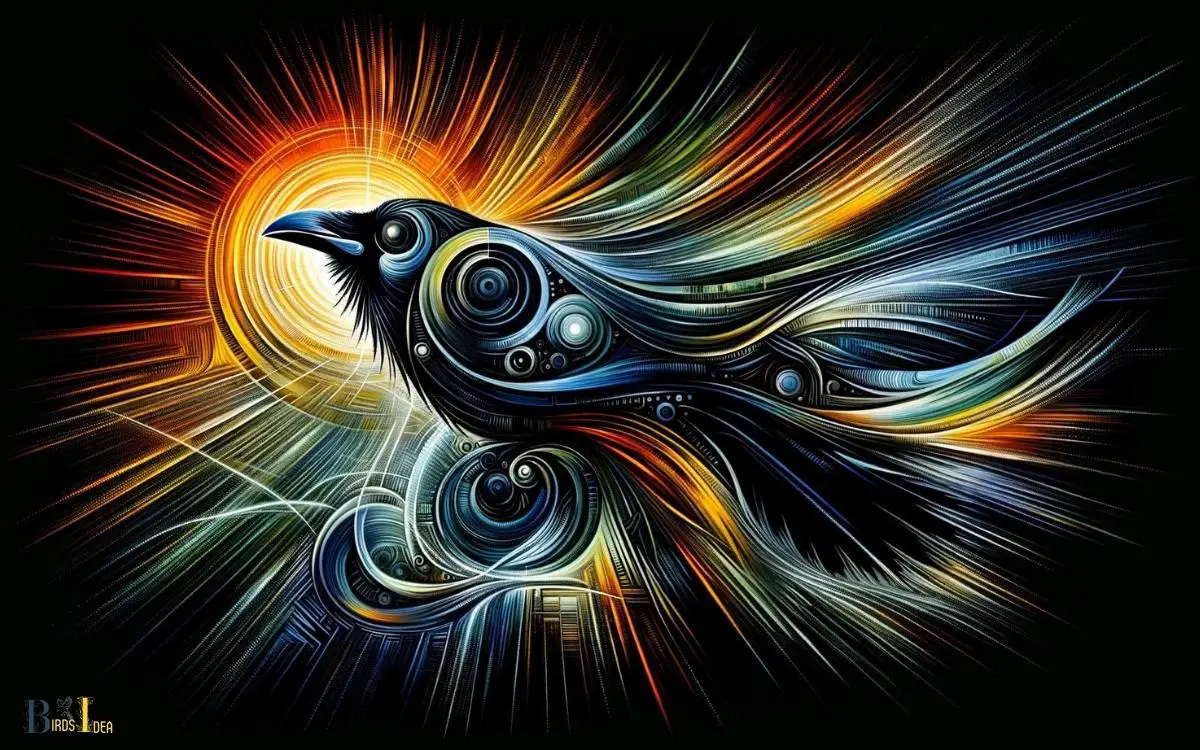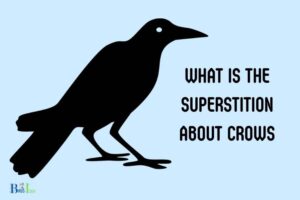What Does a Crow Sound Like: Caw!
Crows are known for their distinctive ‘caw’ sound, which is a loud, harsh, and guttural call.
This sound can vary in pitch and intensity and is used for a variety of communication purposes.
Crows also produce a range of other vocalizations, including rattles, clicks, and bell-like notes, which contribute to their complex communication system.
The crow’s vocalizations are an essential aspect of their behavior and serve several functions:
Examples of crow sounds include:
- The classic ‘caw-caw’ sound, often heard in groups.
- A ‘rattle’ call, which is a rapid series of clicking sounds.
- Soft ‘cooing’ noises used during mating or to soothe young chicks.
The enigmatic language of crows is not just noise; it’s a testament to their intelligence and social complexity, echoing their adaptability and survival skills in diverse environments.

Key Takeaway
Common Crow Calls
The common crow emits a variety of distinct calls to communicate with other crows and to express different emotions and intentions.
These calls include the ‘caw,’ which is commonly associated with crows and is used for a range of purposes such as alerting others to danger or indicating the presence of food.
Crows also use a soft, purring sound to communicate with their mate or offspring. They emit a series of rapid, harsh caws when mobbing predators or intruders.
The ‘scolding’ call is used to express irritation or annoyance, while a series of loud, rapid caws may indicate excitement or agitation.
The complexity and diversity of these calls reflect the highly social nature of crows and their sophisticated communication system.
Vocalization Types
When exploring the vocalization types of crows, it becomes apparent that their calls serve a variety of communication purposes within their social structure.
The vocalization types of crows include:
- Caws: Crows emit distinctive ‘caw’ sounds, which are often associated with territorial defense and alerting others to potential threats.
- Coos and Gurgles: These softer, more melodious sounds are used during courtship and to maintain social bonds within a group.
- Rattles and Knocking: Crows produce these percussive sounds by rapidly opening and closing their bills, often as part of aggressive encounters or territorial disputes.
- Alarm Calls: Crows emit high-pitched, repetitive calls to warn others of potential danger, such as the presence of predators.
These vocalization types enable crows to convey a wide range of information vital for their social cohesion and survival.
Social Communication Sounds
Exploring the vocalization types of crows, particularly in the context of social communication sounds, reveals the nuanced ways in which these birds convey information and maintain group cohesion.
- Crows employ a wide array of social communication sounds, including cooing, cawing, and various complex calls.
- These vocalizations serve to establish territory, signal danger, coordinate group movements, and convey emotional states.
- For example, the rapid, repetitive cawing often indicates the presence of a predator, prompting other crows to join in and mob the threat.
- Subtle variations in tone and pitch can express different levels of urgency or excitement.
The ability of crows to communicate socially through vocalizations underscores their highly developed social structures and cooperative behaviors, contributing to their success as a species in diverse environments.
Aggressive and Alarm Calls
In the context of aggressive and alarm calls, crows exhibit a range of vocalizations that serve to warn of impending danger and provoke defensive responses from their group members.
These calls can be characterized as follows:
- Alarm Calls: Crows emit a series of rapid, high-pitched caws to alert others of potential threats, such as predators or intruders in their territory.
- Scolding Calls: When crows encounter a threat or perceive a disturbance, they produce sharp and repetitive calls to express their agitation and warn others in the vicinity.
- Threat Calls: In confrontational situations, crows may utter harsh and grating calls to intimidate adversaries and defend their territory or resources.
- Chase Calls: During aggressive interactions, crows emit rapid and intense calls while pursuing or evading rivals, signaling their intentions and asserting dominance within the group.
Regional Variations in Cawing
Crows across different regions exhibit distinct variations in their cawing patterns, reflecting the influence of environmental factors and social dynamics on their vocal communication.
- Environmental factors such as habitat type, population density, and availability of food sources can shape the acoustic features of crow calls.
- For instance, crows in urban areas may produce calls with higher frequencies to be better heard over city noise, while those in rural areas may have lower frequency calls.
- Social dynamics within crow communities, such as dominance hierarchies and group cohesion, can also contribute to regional variations in cawing.
Understanding these regional variations in cawing not only provides insights into the adaptability of crows to diverse environments but also sheds light on the complex nature of their vocal communication system.
Environmental Influences on Crow Sounds
Crows are highly adaptable birds whose vocalizations are influenced by various environmental factors.
Understanding how their sounds change in different habitats and seasons provides valuable insights into their behavior and communication.
Impact of Habitat on Vocalization
Crows inhabit a diverse range of environments, from urban areas to forests, and their vocalizations are adapted to suit these surroundings.
In urban settings, where they often interact with humans and encounter ambient noise, crows may produce louder and more varied calls.
These calls may serve the dual purpose of communication within the crow community and as a response to external stimuli, such as potential threats.
In contrast, crows in forested areas may exhibit more nuanced vocalizations, possibly due to the need for subtler communication in densely vegetated environments.
The acoustic properties of different habitats can affect how far crow calls carry, influencing the range over which communication occurs. Crows may adjust their vocalizations to navigate and exploit resources in specific habitats.
Seasonal Variations in Crow Vocalizations
Crow vocalizations undergo noticeable changes throughout the seasons, reflecting the birds’ shifting priorities and behaviors.
During the breeding season, crows engage in more complex and frequent vocalizations as part of courtship rituals and territory establishment.
The calls during this period often serve as indicators of individual identity and reproductive status.
In the autumn, crows engage in communal roosting, and the vocal dynamics shift accordingly.
The roosting sites become focal points for intense social interactions, leading to a rise in the frequency and diversity of vocalizations.
These communal roosts serve not only as places to rest but also as hubs for information exchange and social bonding.
Winter vocalizations may be more subdued, reflecting a period of reduced territorial disputes and reproductive activities.
Crows may focus on cooperative behaviors, such as group foraging, and adjust their vocalizations accordingly.
Understanding the interplay between habitat and seasonal influences on crow vocalizations provides ecologists and ornithologists with a broader perspective on crow behavior.
It underscores the adaptability of these intelligent birds and highlights the intricate ways in which environmental factors shape their communication strategies.
Conclusion
The vocalizations of crows encompass a wide range of sounds, from the common ‘caw’ to various social and aggressive calls.
These calls serve as a means of communication within the crow community and can vary regionally.
The juxtaposition of these vocalizations creates a complex auditory landscape, contributing to the overall understanding of crow behavior and social dynamics.






